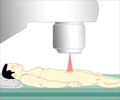A team of researchers have reported the most comprehensive retrospective study ever conducted to compare how the major types of prostate cancer treatments stack up to each other.

The analysis shows that for people with low-risk prostate cancer, the various forms of treatment vary only slightly in terms of survival – the odds of which are quite good for men with this type of cancer, with a 5-year cancer-specific survival rate of nearly 100 percent. But the cost of radiation therapy is significantly more expensive than surgery for low-risk prostate cancer, they found.
For intermediate- and high-risk cancers, both survival and cost generally favored surgery over other forms of treatment – although combination external-beam radiation and brachytherapy together were comparable in terms of quality of life-adjusted survival for high-risk prostate cancer.
"Our findings support a greater role for surgery for high-risk disease than we have generally seen it used in most practice settings," said urologist Matthew Cooperberg, MD, MPH who led the research. Cooperberg is an assistant professor of urology and epidemiology and biostatistics in the UCSF Helen Diller Family Comprehensive Cancer Center.
The UCSF Helen Diller Family Comprehensive Cancer Center is one of the country's leading research and clinical care centers, and it is the only comprehensive cancer center in the San Francisco Bay Area.
Many Treatment Options, but Few Cost Analyses
Advertisement
There are multiple types of treatment for this form of the disease, including various types of surgery (open, laparoscopic or robot-assisted); radiation therapy (dose-escalated three-dimensional conformal radiation therapy, intensity-modulated radiation therapy and brachytherapy); hormone therapies; and combinations of each of these. Many men with low-risk prostate cancer do not need any of these treatments, and can be safely observed, at least initially.
Advertisement
"There is very little solid evidence that one [approach] is better than another," said Cooperberg. The motivation for the new study, however, was that there are also few data examining the differences in terms of cost-effectiveness – the price to the health care system for every year of life gained, with adjustment for complications and side effects of treatments.
The new study was the most comprehensive cost analysis ever, and it compared the costs and outcomes associated with the various types of treatment for all forms of the disease, which ranged from $19,901 for robot-assisted prostatectomy to treat low-risk disease, to $50,276 for combined radiation therapy for high-risk disease.
The study did not consider two other approaches for dealing with prostate cancer: active surveillance, where patients with low-risk cancer are followed closely with blood tests and biopsies and avoid any initial treatment; and proton therapy, which is much more expensive and has already been shown in multiple studies not to be cost-effective, said Cooperberg.
Source-Eurekalert



![Prostate Specific Antigen [PSA] & Prostate Cancer Diagnosis Prostate Specific Antigen [PSA] & Prostate Cancer Diagnosis](https://images.medindia.net/patientinfo/120_100/prostate-specific-antigen.jpg)










